Description: Qualified teacher and online tutor Tina shares her thoughts on how to best engage young learners and teenagers to be more motivated in their studies.
“If a child can’t learn the way we teach, maybe we should teach the way they learn” Ignacio Estrada.
Many times we wonder what we can do to motivate and engage bored and understimulated young learners or teenagers, who have become disengaged and demotivated.
Trust
Building a rapport is one of the most essential keys to keeping young learners or teenagers engaged and to be understanding of their needs.
Common needs are desiring to be understood and to have a voice.
A great way to incorporate this into teaching is to involve them in a Needs Analysis.
You might want to ask younger learners what they like or dislike about the subject they are learning, or you might want to ask teenagers what they think they struggle with in relation to the subject they are learning.
This can add to personalising their lessons. In addition, including their interests and using topics and activities they can relate with can satisfy that need.

Go and find activities as part of the lesson are great to get them to use the language they are learning, as they talk about their chosen objects.
An extension of this activity could then be presentations, written descriptions and so on.
Challenge
Activities that prompt young learners and teenagers to use their higher-order thinking skills.
This can include categorisation, prioritising, problem-solving, and distinguishing.
The more stimulating the better. Recalling and identifying activities we usually see in some course books.
Great examples of categorising topics or lexical sets are school subjects from difficult to least difficult.
Once we have been able to engage young learners and teenagers, we then could look at how we can upgrade their language by exploring examples of the use of language.
You might want to focus on a particular word, expression or phrase.
You could also explore the context or register of the language, whether it is formal or informal.
Playfully adding word building activities to explore the root word and how to turn a word into an adverb or adjective can then lead to increasing their vocabulary.
Variety
Young learners and teenagers become disengaged when they are presented with the same tone and structure in every lesson.
It makes teaching and lessons monotonous and less interesting.
It is essential to provide a routine of teaching different skills.
For example, reading, writing, listening or comprehension, however, it is equally important to add variety within those skills.
Changing the pace of the lesson and considering the environment the young learner and teenager is in can also be a great way to add variety to the lesson.
Activities such as using images the student has to guess can prompt the use of modal verbs like “it could be…,” or “it might be….”.
Another exciting way to add variety is using puzzles and riddles. Like the odd one out, to promote the use of language to justify the choice.

Goals
We all want young learners and teenagers to reach their full potential and raise their confidence to achieve great things.
This might be the ultimate goal, however, the route to get there, needs to be adopted and tailored to each individual.
So being flexible. Plan lessons to delivering lessons to changing the teaching approach during lessons is crucial.
This helps young learners and teenagers excel in any subject.
“If you told a child a thousand times, and he still does not understand, then it is not the child who is a slow learner” Walter Barber.
By tutor Tina. Contact Us

